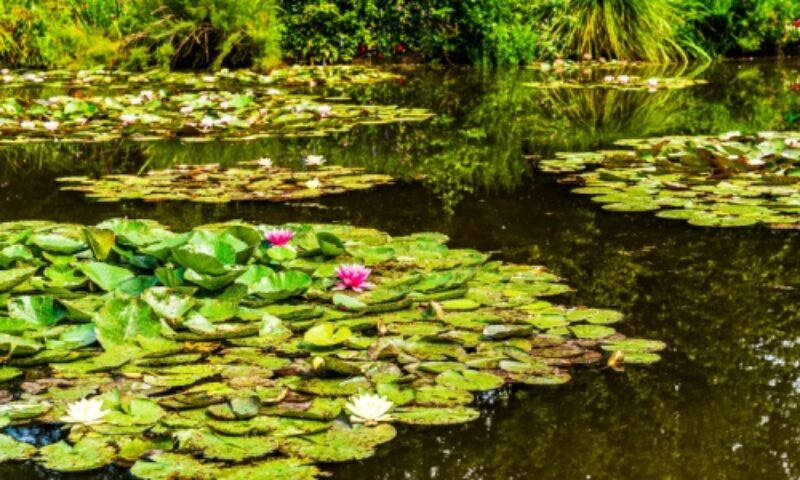Many famous painters have immortalised the incredible landscapes of the places they lived or visited in paintings hanging in museums around the world.
Have you ever wanted to step into a painting? These five beautiful locations captured in famous landscape paintings could give you a chance to do just that.
1. ‘The Starry Night’ by Vincent van Gogh
Many of Vincent van Gogh’s later paintings were his interpretations of the Saint-Rémy-de-Provence in the south of France.
‘The Starry Night’, one of van Gogh’s most famous paintings, depicts the view from the east-facing window of his asylum room here: a swirling night sky and the village glowing in the distance.
The small town still pays homage to its resident painter, with a reconstruction of the room where he lived and more than 20 large-scale reproductions of his most famous paintings in the locations where they were first created.
And if you would like to see ‘The Starry Night’ in person, it has been on display in The Museum of Modern Art in New York since 1941.
2. ‘The Oxbow’ by Thomas Cole
‘The Oxbow’ is one of the most recognisable American landscape paintings and its realistic oxbow lake and the dark clouds swirling overhead has been copied or imitated by many artists since its first exhibition in 1836.
In fact, the original name of the painting – and the perspective Cole had when he painted it if you would like to recreate the view for yourself – is ‘View from Mount Holyoke, Northampton, Massachusetts, after a Thunderstorm’.
The traprock mountain is known for its spectacular views and historic summit house, which you can still visit today. If you’d like to explore the area that inspired this captivating painting, there are over 40 miles of trails across the national park for you to experience.
You can see ‘The Oxbow’ for yourself at The Met Fifth Avenue in New York.
3. ‘The Valley of the Creuse, Sunset’ by Claude Monet
In 1889, several years before he painted his world-famous water lily series, Monet spent several months living in a tiny countryside village in France.
This area – about an hour’s drive north of Limoges – is the least visited part of France, but inspired 23 of Monet’s paintings, including ‘The Valley of the Creuse, Sunset’ and ‘Rapids on the Petite Creuse at Fresselines’.
Indeed, the natural beauty of the local area encouraged around 500 artists – including Francis Picabia and Wynford Dewhurst – to stay in the local village of Crozant to fuel their creativity.
The local area is proud of all the incredible paintings it has inspired and so has created a self-guided walking route, dotted with information posts, so you can explore the locations that moved these artists to create.
‘The Valley of the Creuse, Sunset’ is on display at Unterlinden Museum in Alsace.
4. ‘The Cornfield’ by John Constable
Constable’s painting depicts a boy lying flat by a pool to drink its cool water after a long day of herding sheep.
This vision of the countryside in high summer was painted in Constable’s London studio in 1826 and was inspired by a winding lane in Suffolk.
Constable had walked down Fen Lane many times as a child to commute from his village of East Bergholt to Dedham, where he attended school.
You can still walk down this lane today to recount the journey he used to take and see how much the landscape has transformed over the past two centuries.
‘The Cornfield’ never sold, but a committee of friends and admirers – including William Wordsworth and Michael Faraday – bought the painting and presented it to the National Gallery in 1827 as a tribute to Constable after his death.
It is still on display there in London today.
5. ‘The Great Wave Off Kanagawa’ by Katsushika Hokusai
‘The Great Wave Off Kanagawa’ might be one of the most widely recognisable Japanese paintings ever created.
The woodblock print depicts fishermen battling large waves, with Mount Fuji peeking out from the ocean in the background.
The boats are in Edo (Tokyo) Bay, just off the present-day Kanagawa-ku, Yokohama, with Edo to the north and Mount Fuji to the west. Since the boats were headed south, they were likely on their way to Sagami Bay to collect a cargo of fish for sale.
Only around 100 prints, in varying conditions, are thought to have survived into the 21st century and are available to view in several museums around the world, including the Art Institute of Chicago in the US or the Palazzo Maffei Casa Museo in Verona, Italy.

